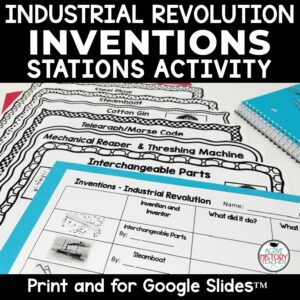
Teaching the industrial revolution inventions can be so boring! Our textbooks often put the industrial revolution inventions in multiple places and they are often just a sentence or two! Getting students to process the impact of the industrial revolution inventions in a meaningful way is always my goal.
When I put this lesson together, I wanted to get kids up and moving. What better way to teach the industrial revolutions inventions than with a station activity.
So how does it work?
- I arranged 6 stations. Each station has an invention (Cotton Gin, Steel Plow, Interchangeable parts, Telegraph/Morse Code, Steamboat, Mechanical Reaper/Threshing Machine) assigned to it.
- If I’m being “extra” that day, I’ll copy each invention off on a different color of paper or card stock.
- I copied off the readings (one page each) and put them in sheet protectors. So that students don’t have to all crowd around 1 reading, I ran 2 copies per group.
- I copied off one graphic organizer per student.
- Students rotate through each invention (I gave them about 4 minutes per station).
- While at the station, they take notes about the inventor, the invention and the impact of the invention.
When all stations are complete, we hold a quick class discussion on each invention. To finish the lesson, I have students complete a quick exit ticket.
As a bell ringer the next class period, I always ask follow up review questions to see if they remember the impact of these inventions. If I need to go deeper with this content, I always try to find a podcast (or part of a podcast) or video to follow up.
Why do I love this activity?
- It’s quick (averaging 25-30 minutes) and gets straight to the point.
- Students are up and moving and NOT sitting through a lecture.
- Once I copy and prep it, I keep it in a filing cabinet. All I have to do each year is copy off the graphic organizer again.
- It’s PERFECT for a day when you will have a substitute.
- It puts all of the important inventions in one lesson – no need to dig through the textbook.
And the best part? It’s already DONE for you! Check out this lesson here.
This post may contain affiliate links.


